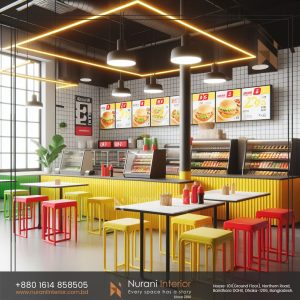Sharing 10 Tips: Architect’s Guide to Designing Dynamic Food Courts
1. Thematic Unity:
Initiate the design process by cultivating a cohesive theme or concept that harmonizes the food court’s visual narrative. This theme should encapsulate cultural motifs, contemporary trends, or local essence, reflected consistently in design elements, color schemes, and decor.
2. Diverse Seating Schemes:
Introduce a versatile range of seating options to cater to various group sizes and dining preferences. Strategically intermix communal tables, intimate booths, bar-style seating, and alfresco choices to offer an assortment of dining experiences.
3. Intuitive Spatial Layout:
Craft an open and fluid layout that beckons exploration. Ensure ample walkways between food stalls and seating zones, avoiding congestion. Employ clear signage and a thoughtful spatial arrangement to optimize accessibility and flow.



4. Distinctive Branding Integration:
Collaborate with food vendors to cultivate distinctive branding and signage that exude individuality. This not only adds character but also aids in easy recognition and recall for visitors.
5. Ambiance Amplification through Lighting:
Harness the power of lighting to orchestrate the desired ambiance. Blend natural light with ambient fixtures and targeted focal lighting to sculpt an inviting atmosphere, adaptable to different times of the day.
6. Green Elements and Artistry:
Infuse verdant touches like indoor greenery or vertical gardens to infuse vitality. Additionally, curated art installations or murals serve as focal points, elevating the visual allure and ambiance.

7. Technological Fusion:
Seamlessly integrate technology to augment the visitor experience. Incorporate features such as digital menu boards, interactive touchscreens, or charging stations, embracing modern amenities.
8. Entertainment Hub Creation:
Envision occasional events or entertainment to invigorate the space. Live music, themed nights, or culinary workshops transform the food court into a dynamic social nucleus.
9. Sustainability as Design Philosophy:
Infuse sustainability practices into the architecture—utilize recyclable materials, advocate for reusable utensils, and implement waste reduction strategies like composting or food donation programs.
10. Adaptive Evolution:
Foster a culture of feedback from both visitors and vendors, facilitating continual enhancements to the food court’s design and offerings. Flexibility and adaptability are crucial for sustained relevance.




